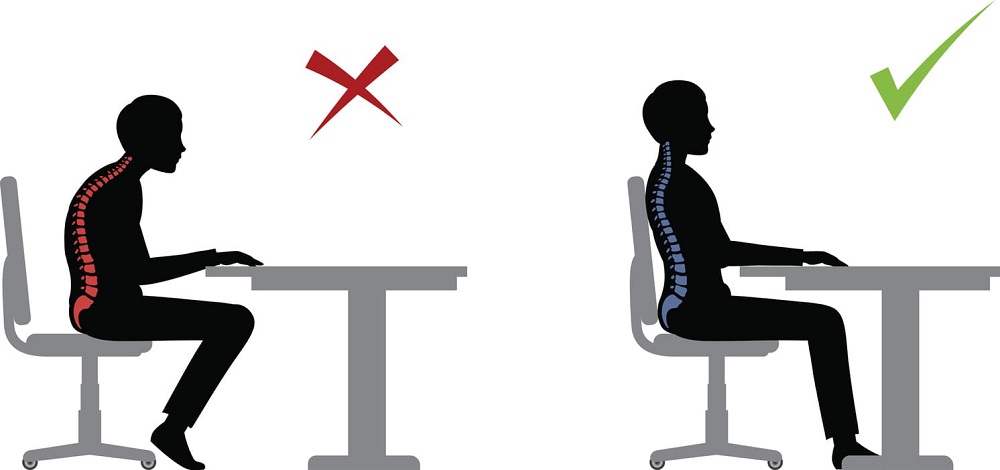Ever stand up after a long workday and feel like you’re twice your age?
Maybe your lower back throbs. Maybe your neck feels stiff. Maybe you’ve caught yourself hunched like a shrimp over your laptop. If that sounds familiar, you’re not alone.
Back pain from sitting too long is one of the most common complaints among adults today—especially those of us working desk jobs, studying for hours, or even gaming deep into the night. But here’s the good news: your desk posture back pain isn’t just about your back. It’s about your setup. And that means it can be fixed.
Let’s talk about how.
✅ Key Takeaways (If You’re Skimming)
-
Your desk posture can silently wreck your back if left unchecked
-
Small, affordable changes to your desk setup make a huge difference
-
The goal is movement, alignment, and support—not expensive gadgets
-
Bad posture habits are fixable with mindful routines and the right furniture
The Real Reason Your Back Hurts at the Desk
You might think it’s your chair, your mattress, or age creeping up on you. But often, it’s just the way you sit… and how long you stay that way.
Prolonged sitting = body shutdown
When we sit for hours—especially with poor posture—our muscles switch off. Blood flow slows. Our spine compresses. According to the Mayo Clinic, sitting for extended periods can increase pressure on your lower back and even shorten your hip flexors, which throws off your whole posture.
The worst part? We often don’t notice until we’re stiff, achy, or worse—injured.
What Does Bad Desk Posture Look Like?
We’ve all done it.
-
Slumping forward like Gollum on a laptop
-
Leaning to one side with an elbow propped up
-
Sitting with legs crossed under you for hours
-
Tilting your head down to look at a screen below eye level
These small habits pile up. Over time, they lead to:
-
Lower back pain
-
Neck and shoulder stiffness
-
Wrist and elbow strain
-
Poor circulation and fatigue
But here’s the flip side: a few targeted fixes can reverse the damage and help you feel strong again.
Fix #1: Align Your Monitor With Your Eyes
Your screen should be at or just below eye level.
If you’re looking down, your neck and upper spine are taking the hit. This is especially common with laptops and low monitors.
Simple fixes:
-
Use a laptop stand or stack books to raise the screen
-
External keyboard + mouse = instant posture upgrade
-
Center the screen—don’t crane to the side
👀 Tip: Your eyes should land on the top third of the screen without tilting your head.
Fix #2: Your Chair Is More Important Than You Think
You don’t need a $900 ergonomic chair—but you do need a seat that supports your natural spine curve.
Look for:
-
Lumbar support (even a small cushion or rolled towel helps)
-
Feet flat on the floor or on a footrest
-
Knees at 90 degrees or slightly lower than hips
🎯 Bonus: Adjust your armrests so your shoulders can relax.
Fix #3: Sit Back—Don’t Perch!
One of the sneakiest posture traps? Perching on the edge of your seat.
It feels active, but it leaves your spine unsupported and your core disengaged. Over time, this leads to fatigue and slouching.
🪑 Instead: Sit all the way back with your hips touching the back of the chair. Let the backrest do its job.
Fix #4: Move Every 30–60 Minutes
Yes, even with a perfect setup, sitting still too long is the real enemy.
Our bodies were made to move. Joints stiffen, muscles shorten, and circulation dips when we sit for hours. That’s why movement is your best medicine.
Set a reminder to:
-
Stand up and stretch
-
Walk around the room
-
Do a 1-minute posture reset
-
Try calf raises, shoulder rolls, or spinal twists
🕐 Use a timer or app like Stretchly or Pomodoro breaks.
Fix #5: Train Your Core and Postural Muscles
Even the best chair can’t hold your posture if your muscles are weak.
Building strength in your core, glutes, and upper back can dramatically reduce desk-related back pain.
Try simple daily exercises like:
-
Bird-dogs
-
Glute bridges
-
Dead bugs
-
Planks (even 20 seconds helps!)
-
Resistance band rows
🧠 Think of your core as your posture’s power source.
Fix #6: Keyboard + Mouse Placement Matters
Your arms should fall naturally at your sides with elbows at about 90 degrees. If you’re reaching too far or too high, your shoulders will start to tense.
🎯 Fixes:
-
Keep keyboard and mouse on the same surface
-
Elbows close to your body—not flared out
-
Wrists straight, not bent up or down
🖱 Consider a vertical mouse if you notice wrist pain.
Fix #7: Check Your Lighting and Glare
Eye strain causes us to lean in or tilt awkwardly—messing up posture without realizing it.
🌞 Make sure:
-
The screen is bright enough
-
You reduce glare from windows or overhead lights
-
You’re not squinting or craning forward to read text
💡 Try a monitor light bar or adjustable desk lamp.
Mini Story: Sarah Fixed Her Setup, and Her Back Stopped Screaming
Sarah, 34, worked in tech. Her days started with coffee and ended with heating pads on her lower back. She blamed age, stress, maybe her workouts. But when a physical therapist asked her about her desk setup, it clicked.
She swapped her kitchen chair for a secondhand office chair, raised her laptop with a shoebox, and started taking stretch breaks every hour. Three weeks later? Her back stopped aching. Her focus improved. She started sleeping better.
Tiny changes, big relief.
Your Desk Should Work For You, Not Against You
Back pain from sitting too long isn’t a life sentence. It’s a signal.
Your body’s asking for better alignment, more movement, and just a bit more care.
You don’t need to buy fancy gear or rework your whole home office. Just adjust what you’ve already got—and build a few mindful habits into your day.
Even 1 or 2 of these tips can make a huge difference.
So go ahead—stretch, realign, breathe… and maybe uncross your legs while you’re at it.
🙋 FAQ: Desk Posture and Back Pain
Q: Can a bad chair really cause back pain?
Yes. Without proper lumbar support and positioning, even short sitting sessions can strain your lower back over time.
Q: How often should I take breaks from sitting?
Ideally, every 30–60 minutes. Even a quick stand and stretch helps.
Q: Is standing all day better than sitting?
Not necessarily. Prolonged standing comes with its own issues. The key is movement and variety, not just standing vs. sitting.
Q: Can I fix my posture without buying new furniture?
Absolutely. Use books, pillows, towels—get creative! Focus on alignment, not aesthetics.
Q: Are posture correctors worth it?
They can help remind you to sit up, but they’re not a cure. Strengthening your postural muscles is more effective long-term.
Q: What’s the best sitting position for lower back pain?
Feet flat, hips slightly above knees, back supported. Sit tall—not rigid, just balanced.
Q: Should I worry about posture if I’m young?
Yes. Poor habits now can lead to chronic pain later. Early awareness pays off big time.
Q: How do I know if my monitor is too low?
If your chin tilts downward or you’re leaning in to read, it’s too low. Raise it until your eyes land naturally on the top third of the screen.
Q: Why does my neck hurt after desk work?
Forward head posture, poor screen height, and lack of movement are often the cause. Try adjusting your monitor and stretching your neck and shoulders regularly.
Q: Can working from bed hurt my back?
Definitely. Slouching in bed while working is a recipe for misalignment. If you must, support your back with pillows and use a tray or lap desk to elevate your laptop.


